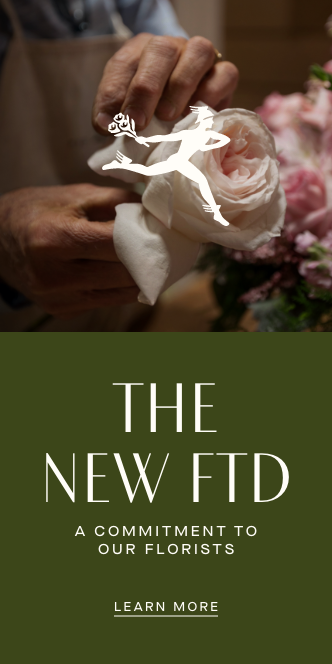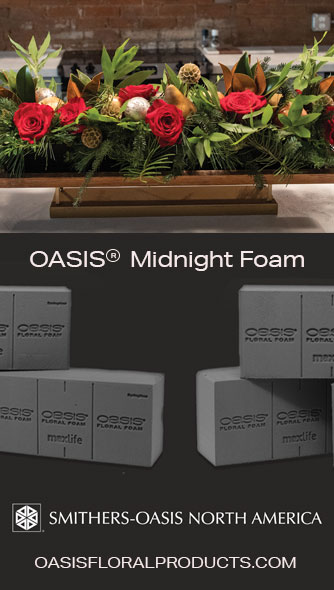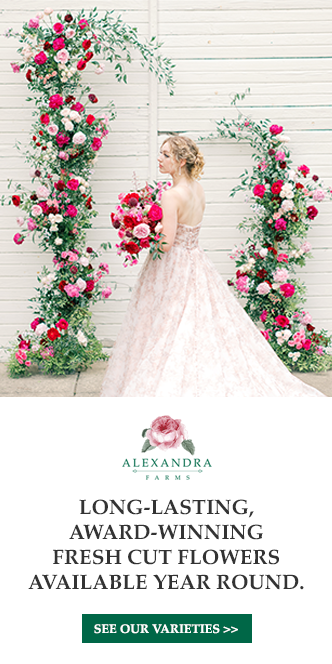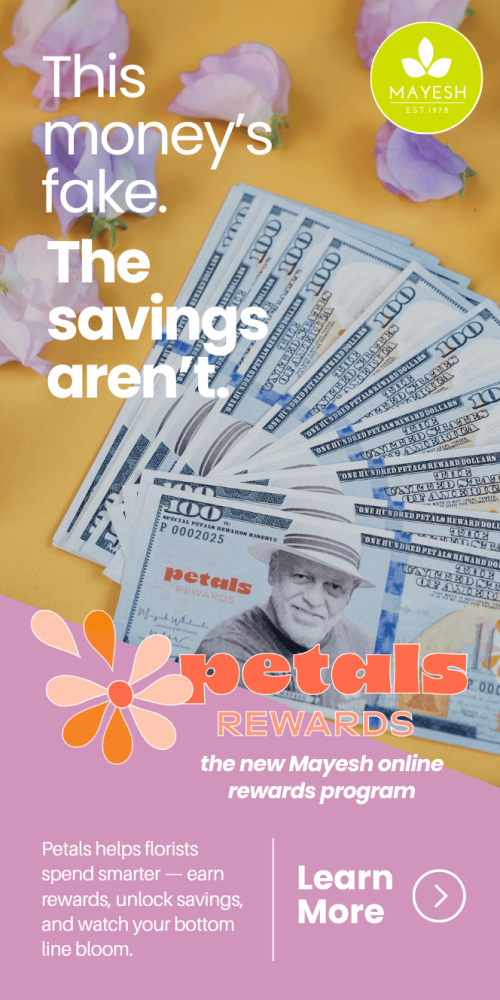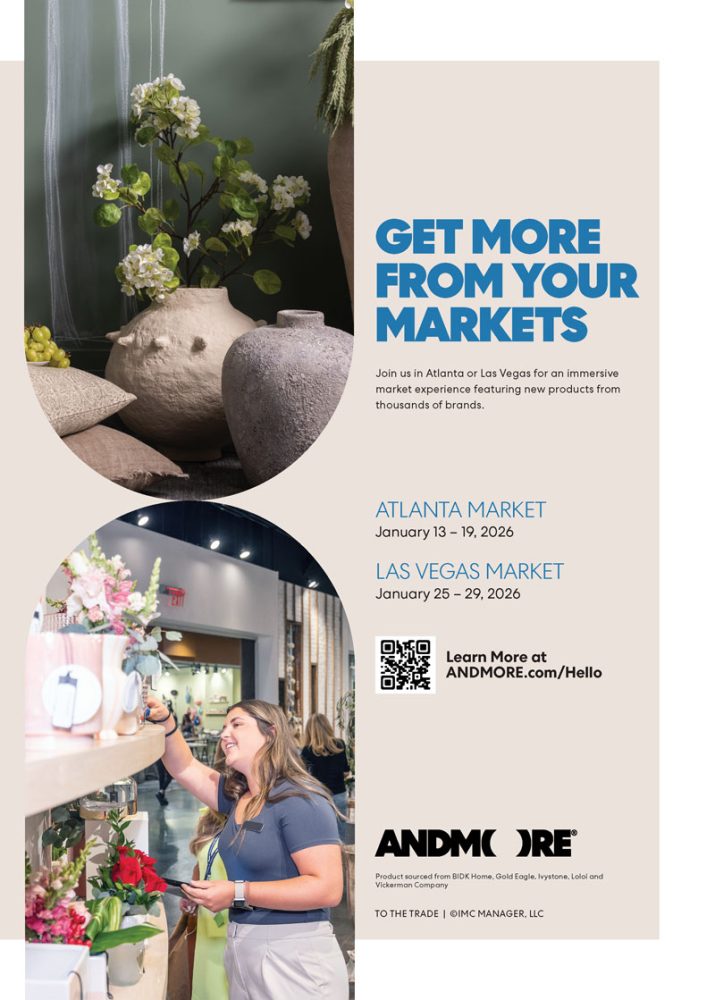How florists are breaking the boundaries of personal flowers.
By Molly Lucille
Bridal bouquets have adorned wedding parties throughout human history. Ancient brides carried bundles of symbolic herbs and blooms, such as dill, considered to be an aphrodisiac; rosemary to represent loyalty; wheat for fertility; and ivy for an unbreakable bond. Garlic and other strong-smelling herbs were carried to ward off evil spirits—or more likely to mask body odor, as bathing was sometimes inaccessible and far less common compared to today. Fast forward to the Victorian era, when bouquets were carefully crafted to include blooms that carried coded messages, a “flower language” expressing the couple’s love story.
A mainstay in weddings around the globe, bridal bouquets have evolved from purely symbolic and utilitarian to an artistic expression of the couple’s personalities. Currently, couples worldwide are exploring the limitless opportunities provided by personal flowers, and florists have arisen to the call. We’ve collected advice and ideas from cutting-edge floral designers to take a closer look at the growing trends in personal flowers. Join us as we walk down the aisle, and through stunning examples of florists and couples who have chosen to move beyond the bouquet.

Photography: Yuleisy Romero @shallwelight
Model: Sofía @sofia.miguelez

Wearing a Bouquet
People throughout history and across cultures have adorned themselves with flowers as a form of expression. In the wedding world, the bohemian flower crown trend ruled the scene in the 1960s and 70s, later experiencing a revival in the mid-2000s. In recent years, we’ve seen an explosion of creativity surrounding how and where to wear flowers. From floral dresses and veils to modern takes on the flower crown (including a stunning flower-adorned afro, as seen in the design by Meghan Campbell, of Twisted Bramble in Seattle) to bridal bouquet boas (as seen in the example by Greenville, S.C-based Hey Jude Florals), wearables are truly having their moment. “There is a magic to wearing flowers, by embodying them you become part of the arrangement,” explains Bethany Steinhauser, a wearable floral artist in Las Vegas. “Wearables are a great way to make a lot out of a little. They’re a great opportunity to deconstruct blooms and see flowers beyond the complete bloom in front of you. Take it apart and make something new,” she says.


This deconstruction is often seen in “floral tattoos.” This trend of creating flower arrangements directly on the body, forming a “tattoo,” is gaining mainstream popularity and appearing in weddings around the world. A floral tattoo requires simple mechanics, often crafted on body tape, such as kinesiology tape, or sometimes (sparingly) glued to the body directly with skin-safe adhesives like eyelash glue. These hands-free flowers pair beautifully with a smaller bouquet or with a statement dress. They offer a great way to bring floral elements from the ceremony to the reception. Before embarking on a floral tattoo project with a client, it’s important to test the flowers, tapes and adhesives ahead of time to rule out skin sensitivity.


Sculptural or Monofloral Bouquets
Bridal bouquets, in no way, will be rendered obsolete. However, there are evolving trends in bouquet structure and style.
For more aesthetically inclined couples, the bouquet can be an artistic expression, resembling a modern art piece. Former sculptor turned floral artist Matthew Blind, of Coach Blind Florals in St Louis, Mo., designs bouquets with unconventional materials, weaving and crafting everyday objects into stunningly intricate creations. “It’s important to not confine yourself to exclusively floral elements when crafting a bouquet,” explains Blind. “You can draw inspiration from the world around you, creating unexpected armatures from any assortment of items. This allows you to create an even more custom arrangement, responding both to the world around you and things important to your clients,” he adds. Binding together these unexpected elements with coated bind wire is an elegant solution to visible mechanics. You can play around with mechanics and experiment with new ways to build an armature—the sky is the limit.


The beauty of flowers often lies in their simplicity, as seen with monofloral bouquets becoming increasingly popular. In general, bouquets are trending smaller, leaving behind the oversized bouquet trend of the last few years. Celebrating a single bloom through a small gathering of monoflorals offers a refreshingly simple moment, showcasing the beauty and majesty of one flower.
For the Groom
From pockets to entire lapels covered in flowers, suit florals are receiving an upgrade. Often, flowers for men are overlooked, with couples opting for just a simple buttonhole or pocket square. These small designs, while classic, are no longer the only option. As seen in these stunning examples by Francoise Weeks, of Francoise Weeks European Floral Design in Portland, there is boundless creativity happening in men’s wearable floral design. “Thinking outside the box is a necessity,” explains Weeks. “If we want our work to stand out, it’s also a lot of fun and rewarding to come up with different ideas and concepts, and to figure out the mechanics to execute it all. Curiosity and perseverance keep our work challenging and interesting,” she adds. Playing off the tailoring, fabric and cut is a great start to forming new approaches to adorning a suit with flowers. Keep in mind that for larger floral applications, movability and durability are key for lengthy wedding days. Experiment with modular designs attached to the lapel and extra firm mechanics to ensure that the wearables will last through a long day of dancing, hugs and parties.



As weddings continue down the route of highly personalized, custom celebrations of each couple’s unique story and identity, so too should our floral designs. There are many ways to encourage your clients to try something new. Toni Sicola, of Tangled Sage in Moab, Utah, is no stranger to this. “I try to use styled shoots as ways to demonstrate new ideas to couples because most will only opt for what they see out there already. The couples will see the flowers on websites and social media, and unfortunately that can become limiting to what they think is possible or what they think will work. It’s really an educational process with the couple to say, ‘you haven’t seen this kind of thing—[it] is kind of new, but it’s definitely possible,’” Sicola explains.
Truly, the only limits on your creativity are the restrictions you place upon yourself. As rigid expectations of traditions begin to lose their grip on modern couples, a wild burst of possibilities has emerged in the realm of personal flowers. Just as sensibilities toward the structure of a wedding party are becoming more customized, so too are flower choices. And while the tradition of carrying a bouquet is likely to always remain at the heart of wedding floral design, we are seeing exciting new trends and innovation with ceremony flowers. From wearables to uniquely crafted creations, join us as we go to infinity and beyond the bouquet.
Tips to Encourage Your Clients to Embrace These New Trends
This is a journey to embark on together!
- If you are interested in nudging wedding clients toward more creative designs, the journey starts with YOU. As an artist, you are in the driver’s seat of your own innovation. Many couples stick to what they know and what they have seen. However, if you confidently share your vision and some ideas you want to try, they are more likely to trust you and jump on board.
- As with any new endeavor, it’s best to have practice, especially if you are trying a new technique on a couple’s big day. Experiment with leftover blooms to test mechanics and ideas and take lots of pictures. You can then share these examples of your unique take on these trends to encourage more couples to opt for something novel.
- Your community is your resource. Learn from others around you and follow designers who share your vision. We can all learn from each other and the more we share original designs, the stronger the signal will be to foster freedom and creativity.












